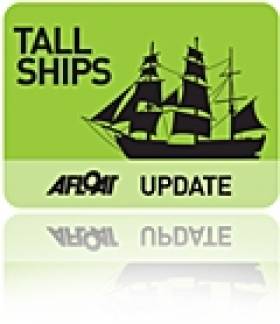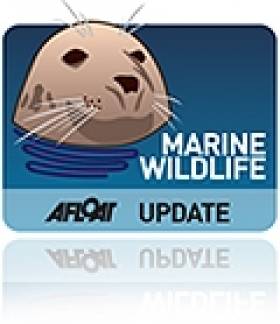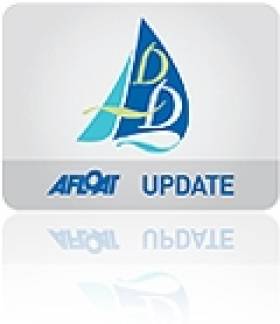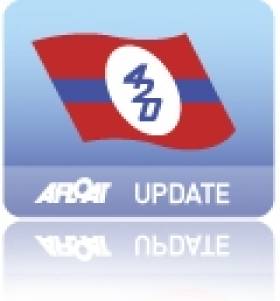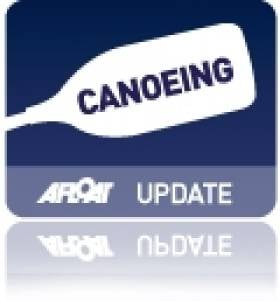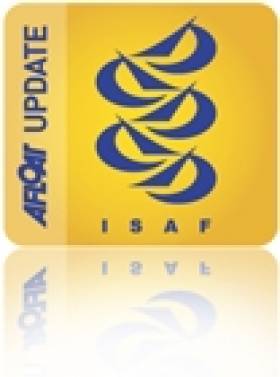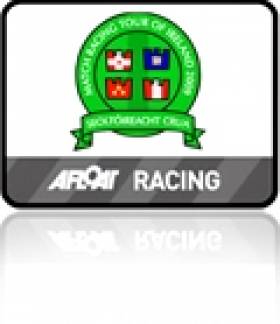Displaying items by tag: video
Tall Ships Videos from Waterford
There's been a range of videos coming into Afloat.ie following the Tall Ships visit to Waterford on the 30th June 201.
Below is a short observational documentary shot on The Tall Ships Race. The piece was shot on a Canon 550d camera with a soundtrack from Irish singer/songwriter Cathy Davey "Sing For Your Supper".
Parade of Sail from Waterford, Ireland for the start of the 2011 Tall Ships Race. Place: Passage East, early morning, 3 July, 2011. Photography by Mik Herman.
And some footage of shoreside festivities by Fionn
Hull Damage To Blame for Stranded Divers
The accident that left four divers stranded off the Wexford coast last weekend was caused by damage to their boat's hull.
Divernet reports that the accident occurred when a section of tubing at the RIB's bow broke away from the hull.
The search operation, which included four RNLI lifeboats, an Irish Coast Guard helicopter and shore unit, was launched last Friday night when the group of divers failed to return to shore.
The divers were rescued at 6am on Saturday morning near the Saltee Islands, where they were found clinging to their upturned RIB.
Dramatic video of the divers' rescue was posted earlier this week on Afloat.ie.
Watch Out for Dolphins in Dublin Bay!
Racers in Dalkey and Killiney Bay have been enjoying the sight of three bottlenose dolphins who have taken up residence in the area.
The trio has attracted much attention in recent weeks due to their playful antics, but the Dublin Bay Sailing Club reminds sightseeing boat owners to be careful not to crowd them.
For guidelines on the correct procedures when encountering dolphins see the relevant DTTAS Marine Notice HERE.
Onboard Raging Bull, Photos and Vid
Raging Bull crew man (and photographer) Brian Carlin has added onboard images from last weekend's Dun Laoghaire to Dingle race. Photos from the Sigma 400, the 2010 ISORA champion, are on the Afloat gallery here.
Onboard vid below too:
420 Class Releases Instructional Video
The International 420 Class Association has launched a free online Training Video (scroll down for video) to provide coaching and training tips for both the beginner and experienced 420 sailors. Sailors are always looking for ways to improve their sailing techniques, improve manoeuvres and get the most out of the time spent on the water and this online resource is set to provide a significant step towards this objective.
The International 420 Class dinghy is an ISAF International Class and two-person dinghy for young sailors. The 420 is an established worldwide performance two-person trapeze and spinnaker racing dinghy and the world's top youth training boat, which is used as the selected equipment at the ISAF Youth Sailing World Championships - offering the perfect pathway from youth to Olympic sailing.There are 56,000 420 dinghies worldwide, sailed at school, club, open, national and international levels. There are many second hand boats available, active clubs and excellent tuition for all levels. In April a brother and sister Patrick and Chloe Crosbie from Royal Cork Yacht Club won the Irish 420 title. In July Emma Geary and Niamh Connolly will represent Ireland at the ISAF Youth Worlds in the Girls Division, racing a 420.
José Massapina, 420 Class Vice-President responsible for the 420 Development Programme commented, "Training and improving techniques can be challenging and this instructional video is a bit like having your own personal video coach to help you get faster and talk you through skills and tactics." Recognizing the input from the partners involved, Massapina added, "We are delighted to have produced the video which has been a major project for the class and I am confident it will benefit many young sailors around the world. Our thanks to Nick Drougas, the Greek sailors sailing and demonstrating the techniques and Icarus who have produced the video."
This is the first specific training video produced by the International 420 Class Association and introduces a range of specific techniques, and demonstrates how to master them in different wind and sea conditions and what to consider when undertaking a range of manoeuvres.
"If you get your technique right you'll be efficient, produce better results and avoid potential injuries." explained Nick Drougas the world class coach behind the video. "Boat set up is explained, alongside body and boat movement. The commentary and visual presentation provide an easily understood training tool. Watch the video, go out and practice, review your day's sailing and improve your skills." he added.
Animated graphic overlays demonstrate specific points to consider in completing manoeuvres, accompanied by an excellent voice over. Designed to help sailors improve their skills and sail their boats better, the video provides a free and excellent resource for 420 sailors around the world. Coaches can also benefit from the video and look at new approaches to training and coaching.
Developed by the International 420 Class Association in partnership with Nick Drougas and Icarus – the training video is broken down into easily digestible sections, which you can view as separate video clips. The video focuses on:
Preparation and General Skills
Lightwinds
Medium Winds
Strong Winds
In addition to the English version, the videos are also available to download in French, Spanish and German. If ISAF MNAs or 420 National Class Association would like a translation of the video into any other languages please contact José Massapina on: [email protected]
Video of Basking Shark Tagging
Cork-based boat charter firm Whale of a Time has posted video on its YouTube channel of the Irish Whale and Dolphin Group (IWDG) tagging a basking shark from its boat Mischief:
Apart from whales, basking sharks are the largest species of marine wildlife to frequent Irish waters.
Shooter Gets Ready to Kayak Round Ireland
Monaghan's Elaine 'Shooter' Alexander will soon begin her challenge to be come the first Northern Irish woman to circumnavigate the island of Ireland by kayak, the OutdoorNI Adventure Blog reports.
On 3 May she will set off from the newly refurbished County Antrim Yacht Club at Belfast Lough on a 1,000-mile trek that's expected to take two months to complete.
Alexander will be paddling clockwise around Ireland, taking on tides, cliffs, headlands - and Ireland's unpredicable weather.
The Ulster woman has been training since last year for the challenge, which is intended to raise funds for the Fermanagh-based SHARE, a charity that brings together disabled and non-disabled people in arts and outdoor-based activities.
“Last year I paddled around Ulster which took 26 days and prepared me for some of what to expect for this expedition," says the competitive kayaker, who represented Northern Ireland twice at the Surf Kayak World Championships.
'Shooter' will also be posting regular updates of her trip on Facebook, Twitter and YouTube. Details on this as well as how to donate are available on her website www.canoearoundireland.com.
The OutdoorNI Adventure Blog has more on the story HERE.
Moth Dinghy Debuts on Dublin Bay
Since our report on Ireland's debut at the Moth worlds in January it was inevitable that one of these high speed sailing dinghies would appear on Irish waters soon enough. Yesterday, John Chambers took his first tack of 2011 on Dublin Bay in a Moth he bought in France. Clearly the high speed foiling craft did not go unnoticed. It got an immediate thumbs up from the nearby DMYC frostbite fleet sailing their penultimate race.
The Bladerider Moth came blasting back from the Baily lighthouse, according to eyewitness accounts. It has hydrofoils on the dagger board and rudder which lift the boat out of the water when sufficient speed is achieved.
It is Chamber's intention to sail the innovative dinghy in this Summer's Dublin Bay Sailing Club (DBSC) summer season.
Video of the Dublin Bay sail plus a photo from Bob Hobby is below:

Moth sailing on Dublin bay. Photo: Bob Hobby
Moth sailing in Ireland on facebook HERE
Finn Dinghy Vid Proves a Big Hit
After the Finn class released its video 'Sailing at its best' on YouTube last week, the response has been nothing short of phenomenal say the class officials. The video is part of a campaign to ISAF to keep the class an Olympic dinghy and the chips are down. To date more than 17,500 views have been recorded from more than 110 countries.
According to YouTube Insight statistics it is the second most viewed sailing video over the past month.
If you haven't seen it yet then check it out on the Afloat home page, scroll down to the bottom of this post or click HERE
The video is just a small part of the classes enhanced media plan. Class President Balazs Hajdu wrote earlier this year, "Today the sailing community realises that media appeal is not only about what you broadcast but also about how you broadcast. By making footage and coverage on Finn races so comprehensive, continuous, available and ground breaking, the International Finn Association brings a message that the Finn is not only a great Olympic class showing close, tactical and fair competition for fit, healthy and heavier elite sportsmen at the top of their game but also that the sport of sailing is able to deliver the media requirements of the IOC and the broadcasters."
Comments posted online about the 2 minute and 40 second video have backed this up
- Outstanding video. This is the pinnacle of dinghy sailing captured on video.
- Fantastic sailing video. This is really promoting Olympic Sailing
- Without a doubt one of the best sailing videos EVER.
- This is simply awesome! Never thought Olympic and small boats sailing is so cool. GREAT GREAT GREAT GREAT
- This is just fantastic! This is actually what we want to see from Olympic Sailing.
- The more I watch it the more I love it.
Die hard Finn fans will also be pleased to know that a longer version is in production and will be released later this month.
Day One Videos from Irish Match Racing Nationals
The Match Racing National Championships are underway in Kinsale this afternoon and we're on the water to bring you vidcasts from competitors at the Round Robin stage. Click read more and listen into George Kingston, Prof O'Connell and Aidan McLaverty.
Vidcasts by Brian Carlin


























